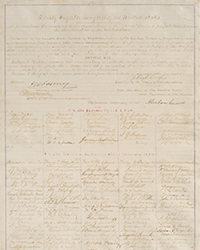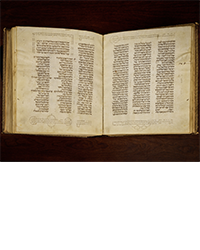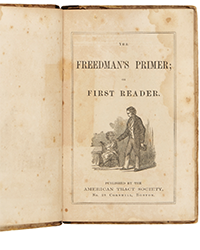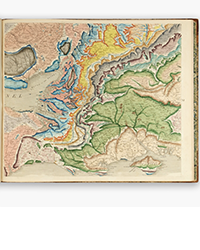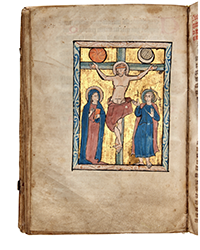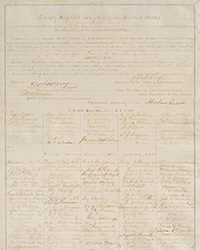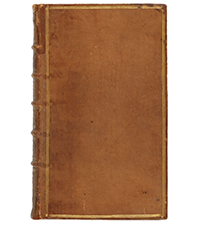Clavreuil, of Paris and London, has issued a catalogue entitled Reflets. That is French for reflections. You won't need to speak French to read the rest the catalogue. The listings are bilingual. Each item is thoroughly described in French and English. The 365 pages attest to its thoroughness. Most of the books are French, and easily fit the category “antiquarian.” It is filled with some of the finest literature France has produced. These are few selections.
Poor Marie Antoinette. Wife of French King Louis XVI, she will forever be remembered for saying something she almost certainly never said – “Let them eat cake.” It supposedly was her response when told the peasants had no bread, a sign of either great heartlessness or extreme ignorance. Her misfortune was to be Queen when the Revolution came, a time when the poll ratings for royalty hit rock bottom. Like her husband, her reign ended at the guillotine. I don't know what happened to the rest of her library, but this book ended up in the latest Clavreuil catalogue. It can now be part of your library, and hopefully bring better fortune than it did for her. The title is Monument élevé à la gloire de Pierre-Le-Grand, ou Relation des travaux et des moyens méchaniques qui ont été employés... (Monument erected to the glory of Peter the Great, or Relation of works and mechanical means that were employed...). The author of this 1777 book was Marin Carburi de Ceffalonie. The sculptor, commissioned by Catherine the Great, was Etienne Falconet. The base was a boulder weighing 600 tons. It had to be moved all the way to St. Petersburg, which meant by sea through the Gulf of Finland and then overland on devices rolling on wooden rails and such to its destination. Hundreds of muzhiks (Russian peasants) pulled it with cables. Here is how they did it. The statue still stands in St. Petersburg. Item 17. Priced at 60,000 € (euros, or approximately $65,216 in U.S. dollars).*
Jean-Francois de la Perouse is perhaps the greatest of French explorers. He also could be thought of as the original “mystery man,” for reasons that will be clear later. His explorations began on the Pacific coast of America. La Perouse visited from Spanish California to Russian Alaska, hoping to find space for a French colony between them. He was also one of many who unsuccessfully tried to find a northwest passage between the Atlantic and Pacific, though most started from the Atlantic side. He next stopped at Hawaii, then on to several Asian countries, Japan, China, Korea, the Philippines, and Russia. In Russia, he handed off his journal to Barthelemy de Lesseps to take back to France. He wanted to be sure the folks back home were informed of his progress, a wise precaution. It was an arduous year-long journey for de Lesseps to make it home. From there, la Perouse continued on to Samoa and finally to Botany Bay on the east coast of Australia. It had been settled only a short time earlier by the British, but despite the intense rivalry between the two countries, he was graciously received. Again, he left some notes behind in Botany Bay. After a short stay, Perouse and his men pushed on. He was never heard from again. His disappearance became a great mystery in France. Missions were sent out to find him but none were successful. It would not be until 40 years later that a Pacific island trader was offered some items he thought might have belonged to Perouse. They had been found by natives along the reefs of Vanikoro, part of the Solomon Islands. The items were verified by the last survivor of Perouse's expedition, the messenger de Lesseps. La Perouse's notes were assembled in France and published in this book, Voyage Autour de Monde... published in 1797. The title, voyage around the world, is somewhat ironic as they never made it all the way. Item 60. 35,000 € (US $38,217).
France produced the greatest naturalist of the 18th century, Georges-Louis Leclerc de Buffon. His areas of study and knowledge were immense, as were his writings. If he is not as well-regarded out of France as others, it was because he got many things wrong. He was challenging old ideas with new thoughts but with little human experience to rely on, his theories were off at times. What he did do was ask the questions others did not ask. He challenged the explanations of religion that were even farther off, though challenging them was dangerous. He recognized that species changed, something denied by religious authorities, but did not come up with a theory of evolution. He recognized the earth was older than the 5,000 years Archbishop Usher proclaimed, though nowhere near its actual age. Others would have to come up with many of the answers, but Buffon got the ball rolling. Item 13 is Histoire Naturelle, Générale et Particulière, avec la Description du Cabinet du Roy (natural history, general and particular, with a description of the King's collection), the first edition, published in 45 volumes 1749-1804. 85,000 € (US $92,815).
We've seen great French naturalists and explorers. Here is a book by a man Clavreuil calls “the first great French surgeon.” Ambroise Paré practiced his craft in the 16th century, when describing surgery as “primitive” was an understatement. This was the day of the “barber-surgeon,” a combination you would not see today, but seemed a logical paring then since both used razors to slice off parts of your body. He was evidently good enough that Henry II had Paré accompany him on military campaigns, where his performance was so brilliant that he became the King's first surgeon, a role he would retain with Francois II, Charles IX, Henri III, and Henri IV. Paré was another pioneer who ignored long established procedures, despite condemnation, if he found better ones. One was the ancient Greek, but long forgotten practice of using ligatures to tie off blood vessels after amputation (a common need for a surgeon in war zones). It worked better than the standard cauterization and was less painful, though it would be a few more centuries before the practice was widely adopted. He also came up with numerous other practices and invented various medical devices that offered advantages to surgeons. He published his discoveries in this book, Les Oeuvres de M. Ambroise Paré, conseiller et premier Chirurgien du Roy. Avec les figures et portraicts tant de l’Anatomie que des instruments de Chirurgie et de plusieurs monstres (The Works of Mr. Ambroise Paré, advisor and first Surgeon of the King. With figures and portraits of both anatomy and surgical instruments and several monsters), published in 1575. The “monsters” referred to children or animals born with certain birth defects or unusual animals. Paré published his book in French as he wanted to make it readable by ordinary barber-surgeons (he couldn't speak other languages anyway). Item 90 45,000 € (US $49,100).
This is a book that will mesmerize you, Mémoire sur la découverte du magnétisme animal (thesis on the discovery of animal magnetism), published in 1779. The author was Franz Anton Mesmer, whose name is the source of the word “mesmerize.” The word is still used at times for hypnosis, though it can refer to any form of what we think of as being under a spell. Mesmer talked about animal magnetism, a force that connected all living things, and could be used to affect even inanimate objects. In its day, it became an almost religious social and medical movement. It wasn't built on science or the scientific method, but it developed a wide following, a “mania” in France says Clavrieul. It was highly popular from the 1770s to around 1850, and continued to have a following until the end of the 19th century. After that, it virtually disappeared. We moved on to newer fantasies. Item 74. 2,500 € (US $2,728).
* Marie Antoinette's chair recently sold at Sotheby's in Paris for $2.8 million. This is a much less expensive option for those who want to possess an object that belonged to the star-crossed queen.
Clavreuil may be reached as follows:
London. Stéphane Clavreuil Rare Books, +44 798 325 2200 or stephane@clavreuil.co.uk.
Paris. Librairie Clavreuil, +33 (0)1 43 26 97 69 or basane@librairieclavreuil.com.
Their website is www.librairieclavreuil.com


